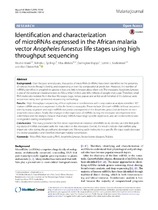| dc.contributor.author | Allam, Mushal | |
| dc.contributor.author | Spillings, Belinda L. | |
| dc.contributor.author | Abdalla, Hiba | |
| dc.contributor.author | Mapiye, Darlington | |
| dc.contributor.author | Koekemoer, Lizette L. | |
| dc.contributor.author | Christoffels, Alan | |
| dc.date.accessioned | 2017-04-13T13:35:29Z | |
| dc.date.available | 2017-04-13T13:35:29Z | |
| dc.date.issued | 2016 | |
| dc.identifier.citation | Allam, M. (2016). Identification and characterization of microRNAs expressed in the African malaria vector Anopheles funestus life stages using high throughput sequencing. Malar Journal, 15:542 | en_US |
| dc.identifier.issn | 1475-2875 | |
| dc.identifier.uri | http://hdl.handle.net/10566/2736 | |
| dc.identifier.uri | http://dx.doi.org/10.1186/s12936-016-1591-0 | |
| dc.description.abstract | Background: Over the past several years, thousands of microRNAs (miRNAs) have been identified in the genomes of various insects through cloning and sequencing or even by computational prediction. However, the number of miRNAs identified in anopheline species is low and little is known about their role. The mosquito Anopheles funestus is one of the dominant malaria vectors in Africa, which infects and kills millions of people every year. Therefore, small RNA molecules isolated from the four life stages (eggs, larvae, pupae and unfed adult females) of An. funestus were sequenced using next generation sequencing technology. Results: High throughput sequencing of four replicates in combination with computational analysis identified 107 mature miRNA sequences expressed in the An. funestus mosquito. These include 20 novel miRNAs without sequence identity in any organism and eight miRNAs not previously reported in the Anopheles genus but are known in non-anopheles mosquitoes. Finally, the changes in the expression of miRNAs during the mosquito development were determined and the analysis showed that many miRNAs have stage-specific expression, and are co-transcribed and co-regulated during development. Conclusions: This study presents the first direct experimental evidence of miRNAs in An. funestus and the first profiling study of miRNA associated with the maturation in this mosquito. Overall, the results indicate that miRNAs play important roles during the growth and development. Silencing such molecules in a specific life stage could decrease the vector population and therefore interrupt malaria transmission. | en_US |
| dc.language.iso | en | en_US |
| dc.publisher | BioMed Central | |
| dc.rights | All the contents of this journal, except where otherwise noted, is licensed under a Creative Commons Attribution License | |
| dc.subject | Anopheles funestus | en_US |
| dc.subject | Malaria | en_US |
| dc.subject | MicroRNA | en_US |
| dc.subject | Non-coding RNA | en_US |
| dc.subject | Vector-borne diseases | en_US |
| dc.title | Identification and characterization of microRNAs expressed in the African malaria vector Anopheles funestus life stages using high throughput sequencing | en_US |
| dc.type | Article | en_US |
| dc.description.accreditation | ISI | |

